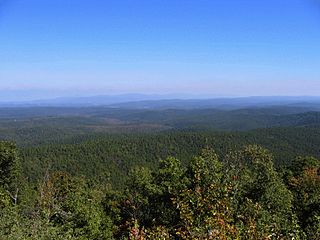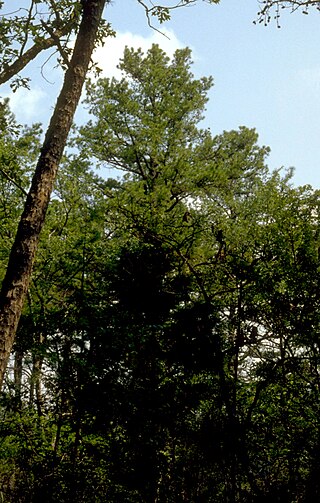
The Ozarks, also known as the Ozark Mountains, Ozark Highlands or Ozark Plateau, is a physiographic region in the U.S. states of Missouri, Arkansas, Oklahoma and the extreme southeastern corner of Kansas. The Ozarks cover a significant portion of northern Arkansas and most of the southern half of Missouri, extending from Interstate 40 in central Arkansas to Interstate 70 in central Missouri.

The Ouachita National Forest is a vast congressionally-designated National Forest that lies in the western portion of Arkansas and portions of extreme-eastern Oklahoma, USA.

The Boston Mountains is a Level III ecoregion designated by the Environmental Protection Agency (EPA) in the U.S. states of Arkansas and Oklahoma. Part of the Ozarks, the Boston Mountains are a deeply dissected plateau. The ecoregion is steeper than the adjacent Springfield Plateau to the north, and bordered on the south by the Arkansas Valley. The Oklahoma portion of the range is locally referred to as the Cookson Hills. There are several theories of how the mountains were named, though apparently none are related to the Massachusetts city.

The Ozark – St. Francis National Forest is a United States National Forest that is located in the state of Arkansas. It is composed of two separate forests, Ozark National Forest in the Ozark Mountains; and St. Francis National Forest on Crowley's Ridge. Each forest has distinct biological, topographical, and geological differences.

The Ouachita Mountains, simply referred to as the Ouachitas, are a mountain range in western Arkansas and southeastern Oklahoma. They are formed by a thick succession of highly deformed Paleozoic strata constituting the Ouachita Fold and Thrust Belt, one of the important orogenic belts of North America. The Ouachitas continue in the subsurface to the northeast, where they make a poorly understood connection with the Appalachians and to the southwest, where they join with the Marathon uplift area of West Texas. Together with the Ozark Plateaus, the Ouachitas form the U.S. Interior Highlands. The highest natural point is Mount Magazine at 2,753 feet (839 m).

The Saline River, also known as Saline Creek, is a 202-mile-long (325 km) tributary of the Ouachita River in the south central portion of the U.S. state of Arkansas. It is the longest river that flows entirely within the state of Arkansas.

Hot Springs National Park is an American national park in central Garland County, Arkansas, adjacent to the city of Hot Springs, the county seat. Hot Springs Reservation was initially created by an act of the United States Congress on April 20, 1832, to be preserved for future recreation. Established before the concept of a national park existed, it was the first time that land had been set aside by the federal government to preserve its use as an area for recreation. The hot spring water has been popularly believed for centuries to possess medicinal properties, and was a subject of legend among several Native American tribes. Following federal protection in 1832, the city developed into a successful spa town.

The Fourche La Fave River is a tributary of the Arkansas River, approximately 151 miles (243 km) long, in western Arkansas in the United States. It drains part of the northern Ouachita Mountains west of Little Rock.
The Black Fork Mountain Wilderness Area is located in the U.S. states of Arkansas and Oklahoma. Created by an act of Congress in 1984, the wilderness covers an area of 13,139 acres (53 km²). The Arkansas portion contains 8,430 acres (34.1 km2) and the Oklahoma portion contains 5,140 acres (20.8 km2). Located within Ouachita National Forest, the wilderness is managed by the U.S. Forest Service. The area is about 2 miles (3.2 km) north of Page, Oklahoma, and about 6 miles (9.7 km) north of Mena, Arkansas.

Ouachita National Recreation Trail is a 223-mile (359 km) long, continuous hiking trail through the Ouachita Mountains of Oklahoma and Arkansas. It is the longest backpacking trail in the Ouachita National Forest, spanning 192 miles across its length. Approximately 177 miles of the trail is in Arkansas and 46 miles of the trail is in Oklahoma. The trail is used by hikers, backpackers, hunters, and mountain bikers. It is a non-motorized single track trail open only to foot traffic and partially open to mountain bicycles. Segments opened to mountain bikes are from the western terminus of the Ouachita Trail at Talimena State Park to the Big Cedar trailhead on US Highway 259 at approximately Mile Marker (MM) 30.5 in Oklahoma, and from the Talimena Scenic Drive Trailhead at MM 54.1, east to Highway 7 at mile 160.4, north of Jessieville, Arkansas.

The Salmon–Huckleberry Wilderness is a wilderness area located on the southern side of Mount Hood in the northwestern Cascades of Oregon, in the United States. It lies within the Mount Hood National Forest and comprises 62,061 acres (25,115 ha) of land. The United States Congress designated the area Wilderness in 1984.

The Mark O. Hatfield Wilderness is a wilderness area located on the northern side of Mount Hood in the northwestern Cascades of the U.S. state of Oregon, near the Columbia River Gorge and within Mount Hood National Forest. Prior to Wilderness designation it was known as the Columbia Gorge Recreation Area.

The U.S. Interior Highlands is a mountainous region in the Central United States spanning northern and western Arkansas, southern Missouri, eastern Oklahoma, and extreme southeastern Kansas. The name is designated by the United States Geological Survey to refer to the combined subregions of the Ouachita Mountains south of the Arkansas River and the Ozark Plateaus north of the Arkansas. The U.S. Interior Highlands is one of few mountainous regions between the Appalachians and Rockies.

The geography of Arkansas varies widely. The state is covered by mountains, river valleys, forests, lakes, and bayous in addition to the cities of Arkansas. Hot Springs National Park features bubbling springs of hot water, formerly sought across the country for their healing properties. Crowley's Ridge is a geological anomaly rising above the surrounding lowlands of the Mississippi embayment.

Highway 28 is designation for three east–west state highways in Western Arkansas. Two segments together running from the Oklahoma state line to Ola have been established since the original 1926 Arkansas state highway numbering, with the third segment designated in 1963. All three highways are rural, two-lane roads with relatively low traffic serving a sparsely populated and forested part of Arkansas. The highways are maintained by the Arkansas Department of Transportation (ARDOT).
The Caney Creek Wilderness is a rugged 14,460-acre (58.5 km2) segment of the Ouachita National Forest just outside of the mountain town of Mena, Arkansas. It was designated by Congress in 1975 as the first wilderness area in Arkansas. The wilderness' main drainage and namesake, Caney Creek, winds through old-growth bottomland forest and is surrounded by tall, steep ridges, with the clear Cossatot River bordering the wilderness on the west side. The wilderness is known for exceptional air and water quality as well as virgin forest and excellent vistas.

Pinnacle Mountain is a 1,011-foot summit and the second highest natural point in Pulaski County, Arkansas; it is also the primary attraction of the 2,356-acre Pinnacle Mountain State Park. Located in the foothills of the Ouachita Mountains approximately 13 miles northwest of downtown Little Rock, Pinnacle Mountain is one of the most iconic landforms of the U.S. Interior Highlands.
The Stanley Shale, or Stanley Group, is a Mississippian stratigraphic unit in the Ouachita Mountains of Arkansas and Oklahoma. First described in Arkansas in 1892, this unit was not named until 1902 by J.A. Taff in his study of the Ouachita Mountains of Oklahoma. Taff assigned the town of Stanley in Pushmataha County, Oklahoma as the type locality, but did not designate a stratotype. After introduction into Arkansas in 1909 by Albert Homer Purdue, the unit was redefined in 1918, when the formation known as the Fork Mountain Slate was abandoned and partially combined into the Stanley Shale. As of 2017, a reference section for the Stanley Shale has yet to be designated.

The Arkansas Valley is a Level III ecoregion designated by the Environmental Protection Agency (EPA) in the U.S. states of Arkansas and Oklahoma. It parallels the Arkansas River between the flat plains of western Oklahoma and the Arkansas Delta, dividing the Ozarks and the Ouachita Mountains with the broad valleys created by the river's floodplain, occasionally interrupted by low hills, scattered ridges, and mountains. In Arkansas, the region is often known as the Arkansas River Valley, especially when describing the history and culture of the region.

















